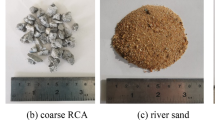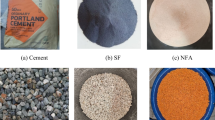Abstract
The high absorption of fine recycled aggregates is indicated as the main difference with respect to fine natural aggregates. This property determines the extra amount of water to be added during mixing to avoid a loss in workability when these aggregates are used for making concrete. Although several methods have been proposed for its determination, none of them has been standardized or has achieved full consensus. In this paper, a method for the determination of absorption based on electrical conductivity is applied. The results from this method and other particular methods proposed in the literature for this type of aggregate are analyzed and compared regarding their representativeness. The outcomes of this study show the suitability of the conductivity method for the effective determination of water absorption of fine recycled concrete aggregate, with relatively low variation and incidence of the operator.








Similar content being viewed by others
References
Hansen TC, Narud H (1983) Strength of recycled concrete made from crushed concrete coarse aggregates. Concr Int 5(1):79–83
Ravindrarajah RS, Tam TC (1987) Recycled concrete as fine and coarse aggregates in concrete. Int J Cem Compos Lightweight Concr 9(4):235–241
Zega CJ, Sosa ME, Di Maio AA (2010) Propiedades de los agregados finos reciclados procedentes de hormigones elaborados con distintos tipos de agregados gruesos naturales. En: 18º Reunión Técnica de la Asociación Argentina de Tecnología del Hormigón. Mar del Plata, Argentina, pp 33–38
Limbachiya MC, Leelawat T, Dhir RK (2000) Use of recycled concrete aggregate in high-strength concrete. Mater Struct 233(33):574–580. https://doi.org/10.1007/BF02480538
Vázquez E, Barra M (2002) Reciclaje y reutilización del hormigón. Monografía CIMNE: Desarrollo sostenible del cemento y del hormigón. 67:43–65
Zega CJ, Di Maio AA (2003) Influencia de las características de los agregados reciclados en la elaboración de hormigones. En: Memorias 15º Reunión Técnica de la Asociación Argentina de Tecnología del Hormigón, Santa Fe, Argentina
Sánchez de Juan M, Alaejos Gutiérrez P (2003) Utilización de árido reciclado para la fabricación de hormigón estructural. En Memorias II Congreso de ACHE de Puentes y Estructuras, Madrid, España
Zerbino R, Giaccio G, Casuccio M, Zega CJ, Martin R, Perera E, Hector S (2006) Empleo de hormigón reciclado para la construcción de losas de pavimento urbano. En: Memorias 16º Reunión Técnica de la Asociación Argentina de Tecnología del Hormigón. Mendoza, Argentina, pp 63–70
Zega CJ, Di Maio AA (2011) Recycled concretes made with waste ready-mix concrete as coarse aggregate. J Mater Civ Eng 23(3):281–286
DIN 4226:2002. Agreggates for concrete and mortar—Part 100: recycled aggregates. German institute for standardization
EHE (2000) Instrucción de hormigón structural. Ministerio de foment, España, p 2008
ACI 555R-01 (2001) Removal and reuse of hardened concrete. Report of American Concrete Institute
JIS A 5021 (2011) Recycled aggregates for concrete. Japanize Industrial standards Committee
IRAM 1531 (2016) Agregado grueso para hormigón de cemento pórtland. Instituto Argentino de normalización y certificación
Khatib JM (2005) Properties of concrete incorporating fine recycled aggregates. Cem Concr Res 35:763–769. https://doi.org/10.1016/j.conbuildmat.2015.03.119
Cartuxo F, de Brito J, Evangelista L, Jiménez JR, Ledesma EF (2015) Rheological behaviour of concrete made with fine recycled concrete aggregates—influence of the superplasticizers. Constr Build Mater 89:26–47. https://doi.org/10.1016/j.conbuildmat.2015.03.119
Zega CJ, Di Maio AA (2006) Comportamiento de hormigones elaborados con agregado fino reciclado. En: 16° Reunión técnica de la Asociación Argentina de Tecnología del Hormigón. Mendoza, Argentina, pp 47–54
Kim S-W, Yun H-D (2014) Evaluation of the bond behavior of steel bars in recycled fine aggregate concrete. Cement Concr Compos 46:8–18. https://doi.org/10.1016/j.cemconcomp.2013.10.013
Evangelista L, de Brito J (2004) Criteria for the use of fine recycled concrete aggregates in concrete production. In: Proceedings of international RILEM conference the use of recycled materials in building and structures. Barcelona, Spain, pp 503–510
Sosa ME, Zega CJ, Di Maio AA (2015) Influence of fine recycled aggregates on compressive strength, static modulus of elasticity and drying shrinkage of concrete. In: Proceedings of international conference on sustainable structural concrete. RILEM. La Plata, Argentina
Evangelista L, de Brito J (2010) Durability performance of concrete made with fine recycled concrete aggregates. Cem Concr Compos 32:9–14. https://doi.org/10.1016/j.cemconcomp.2009.09.005
Zega CJ, Di Maio AA (2011) Use of recycled fine aggregate in concretes with durable requirements. Waste Manag 31:2336–2340. https://doi.org/10.1016/j.wasman.2011.06.011
Pereira P, Evangelista L, de Brito J (2012) The effect of superplasticizers on the workability and compressive strength of concrete with fine recycled concrete aggregates. Constr Build Mater 28:722–729. https://doi.org/10.1016/j.conbuildmat.2011.10.050
Khoshkenari AG, Shafigh P, Moghimi M, Mahmud HB (2014) The role of 0-2 mm fine recycled concrete aggregate on the compressive and splitting tensile strengths of recycled concrete aggregate concrete. Mater Des 64:345–354
Leite MB, Figueiredo Filho JGL, Lima PRL (2013) Workability study of concretes with recycled mortar aggregates. Mater Struct 46:1765–1778. https://doi.org/10.1617/s11527-012-0010-4
Lima PRL, Leite MB (2012) Influence of CDW recycled aggregate on drying shrinkage of mortar. Open J Civ Eng 2:53–57. https://doi.org/10.4236/ojce.2012.22009
Vegas I, Azkarate I, Juarrero A, Frías M (2009) Diseño y Prestaciones de Morteros de Albañilería Elaborados con Áridos Reciclados Provenientes de Escombros de Hormigón. Materiales de Construcción 59(295):5–18. https://doi.org/10.3989/mc.2009.44207
Martinez I, Etxeberria M, Pavon E, Díaz N (2013) A comparative analysis of the properties of recycled and natural aggregate in masonry mortars. Constr Build Mater 49:384–392. https://doi.org/10.1016/j.conbuildmat.2013.08.049
Mardani A, Tuyan M, Ramyar K (2014) Mechanical and durability performance of concrete incorporating fine recycled concrete and glass aggregates. Mater Struct 48:2629–2640. https://doi.org/10.1617/s11527-014-0342-3
Hincapié Henao AM, Aguja López EA (2003) Agregado reciclado para morteros. Revista Universidad Eafit 132(39): 76–89. http://publicaciones.eafit.edu.co/index.php/revista-universidad-eafit/issue/view/117
Castro MJ (2011) Estudio de Morteros con Árido Reciclado de Hormigón. Tesis de Master. Escuela Técnica Superior de Caminos, Canales y Puertos. Universidad Politécnica de Madrid, España
Poon C, Qiao XC, Chan D (2006) Cause and influence of self-cementing properties of fine recycled concrete aggregates on the properties of unbound sub-base. Waste Manag 26:1166–1172. https://doi.org/10.1016/j.wasman.2005.12.013
Kou SC, Poon CS (2009) Properties of self-compacting concretes prepared with coarse and fine aggregates. Cem Concr Compos 31(9):622–627. https://doi.org/10.1016/j.cemconcomp.2009.06.005
Leite MB (2001) Avaliação de propriedades mecãnicas de concretos produzidos com agregados reciclados de resíduos de construção e demolição”. PhD thesis. Escola de Engenharia. Universidade Federal Rio Grande Do Sul. Brazil
ASTM C-128-01, Standard Test Method for Density, Relative Density (Specific Gravity), and Absorption of Fine Aggregate, ASTM
Tam VWY, Gao XF, Tam CM, Chan CH (2008) New approach in measuring water absorption of recycled aggregates. Constr Build Mater 22:364–369. https://doi.org/10.1016/j.conbuildmat.2006.08.009
Damineli BL, Quattrone M, Angulo SC, Taqueda MES, Vanderley JM (2016) Rapid method for measuring water absorption of recycled aggregates. Mater Struct 49(10):4069–4084. https://doi.org/10.1617/s11527-015-0773-5
Rodriguez F, Evangelista L, de Brito J (2013) A new method to determine the density and water absorption of fine recycled aggregates. Mater Res 16(5):1045–1051. https://doi.org/10.1590/S1516-14392013005000074
Tegguer AD (2012) Determining water absorption of recycled aggregates utilizing hydrostatic weighing approach. Constr Build Mater 27:112–116. https://doi.org/10.1016/j.conbuildmat.2011.08.018
Bendimerad AZ, Rozierre E, Loukili A (2015) Combined experimental method to assess absorption rate of natural and recycled aggregates. Mater Struct 48(11):3557–3569. https://doi.org/10.1617/s11527-014-0421-5
Quattrone M, Casacliu B, Angulo CS, Hamart E, Cothenet A (2016) Measuring the water absorption of recycled aggregates, what is the best practice for concrete production. Constr Build Mater 123:690–703. https://doi.org/10.1016/j.conbuildmat.2016.07.019
Rodriguez F, Carvalho MT, Evangelista L, de Brito J (2013) Physical-chemical and mineralogical characterization of fine aggregates from construction and demolition waste recycling plants. J Clean Prod 52:438–445. https://doi.org/10.1016/j.jclepro.2013.02.023
Carrizo L, Sosa ME, Zega CJ, Villagrán Zaccardi YA (2015) Determinación efectiva del estado saturado a superficie seca en arenas de trituración. En: Memorias de la 21° Reunión técnica de la Asociación Argentina de Tecnología del Hormigón, Salta, Argentina
Ueno A, Kokubu K, Ohga H (1998) Basic study on the new testing method of judging the saturated dry conditions of fine aggregates. In: Proceedings of 4th CANMET/ACI/JCI conference: advances in concrete technology, Tokushima, Japan, pp 1481–498
JSCE-C506 (2003) Test method for density and water absorption of slag fine aggregate for concrete by measurement of electric resistance. Japanese Society of Civil Engineers, Tokio, Japón
Kim J, Zi G, Lange DA (2017) Measurement of water absorption in very fine particles using electrical resistivity. Mater J 6(114):957–965. https://doi.org/10.14359/51700994
Sarma VVJ, Bhaskara R (1962) Variation of electrical resistivity of river sand, calcite and quartz powders with water content. Geophysics 4(27):470–479. https://doi.org/10.1190/1.1439048
Jakosky JJ, Hopper RH (1937) The effect of moisture on the direct current resistivity of oil sand and rocks. Geophysics 2(1):34–55. https://doi.org/10.1190/1.1438064
Johnson AI (1962) Methods of measuring soil moisture in the field. Geological Survey Water-Supply Paper 1619-U, United States Government Printing Office, Washington
Florea MVA, Brouwers HJH (2012) Recycled concrete fines and aggregates-the compositions of various size fractions related to crushing history. In 18va Ibausil International conference on building materials, Weimar Alemania, pp 1034–1041
Sosa ME, Lamnek A, Villagrán YA, Benito DA, Zega CJ, Di Maio AA. Composición y propiedades del agregado fino reciclado en función de partículas. Memorias de la 21° Reunión técnica de la Asociación Argentina de Tecnología del Hormigón
Zhao Z, Remond S, Daminot D, Xu W (2013) Influence of hardened cement paste content on the water absorption of fine recycled concrete aggregates. J Sustain Cem-Based Mater 2(3):186–203. https://doi.org/10.1080/21650373.2013.812942
Acknowledgements
The authors express their gratitude to Prof. Ángel Di Maio for his support and advice during the production of this article. The financial support by CONICET (PIP Nº 00039) and FONCyT (PICT 2015-3339) is greatly appreciated as well.
Author information
Authors and Affiliations
Corresponding author
Rights and permissions
About this article
Cite this article
Sosa, M.E., Carrizo, L.E., Zega, C.J. et al. Water absorption of fine recycled aggregates: effective determination by a method based on electrical conductivity. Mater Struct 51, 127 (2018). https://doi.org/10.1617/s11527-018-1248-2
Received:
Accepted:
Published:
DOI: https://doi.org/10.1617/s11527-018-1248-2




